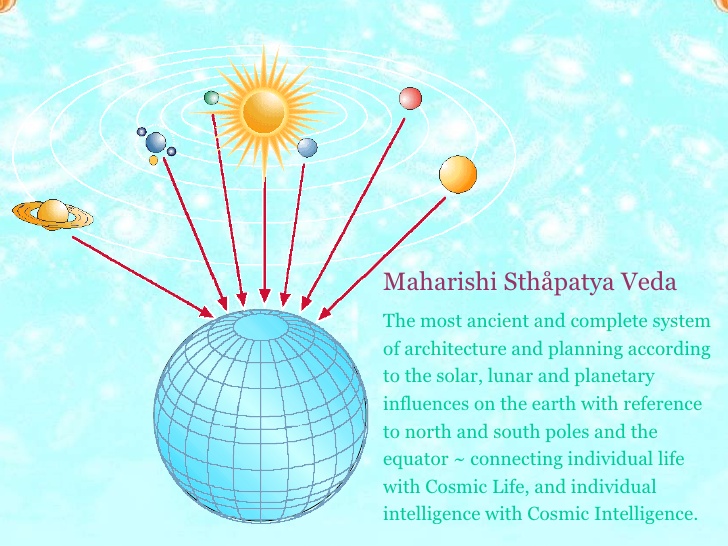Research on Maharishi Sthapatya Veda
(also known as Maharishi Vastu) –
the Foundation of FeelGood® Homes
Examination of the Effects of Living and Working in Maharishi Vastu Buildings.
Compiled by Jon Lipman, AIA, Maharishi Sthapatya Veda Institute, Maharishi University of Management, Fairfield, Iowa ,USA.

The effects of the built environment on human health have been the subject of extensive research in recent years. Examining health-related insights from the world’s most ancient system of architecture provide a leap forward in understanding how buildings affect our health. The ancient Vedic texts of Manasara and Maya Mata propose in detail how influences may be designed into a building to improve the quality of peoples’ lives. And, the texts delineate the damaging influences of improper building design and construction which it proposes will promote anger, fear, chronic disease, and other undesirable qualities. Most research on the effect of buildings on human health is being conducted in a scatter-shot way, in that researchers are selecting subjects of study without an overarching hypothesis regarding the mechanisms by which buildings affect human health. Maharishi Vastu provides such a hypothesis, and so it is providing a basis for deriving many novel experimental models suitable for testing.
Maharishi describes Maharishi Vastu as
“A complete system of architecture and planning according to the solar, lunar, and planetary influences on the earth with reference to North and South Poles and the equator….”
And, that such a system connects individual intelligence with cosmic intelligence. In other words, an ideal system of architecture will take into account the effects of the Earth, the Sun, and solar system upon life within a building or city.
How is this done? The system of Maharishi Vastu architecture is derived in part from the most primal characteristics of the Earth: that it is a sphere that rotates from West to East about an axis that passes through the North and South Poles. As a consequence the Sun and virtually all other celestial objects rotate overhead from East to West. One can therefore deduce that the influences of the celestial objects come at us from the East. From this deduction are derived four key elements of Maharishi Vastu architecture and planning:
1. Human Orientation:
For primary activities it is ideal to align the human body with the influences of the Sun, etc. by facing East. Other orientations will have other, inferior, influences. The specific effects on health are delineated in the ancient texts of the Vedic literature and may therefore be tested.
More Details about Research on Human Orientation
2. Building Orientation:
The buildings we occupy are intermediaries between us and the cosmos. The system proposes therefore that the orientation of buildings also affect our well-being. The effects of the four cardinal directions and the four intermediary directions are described in the Vedic literature and may therefore be tested. Of the individual influences buildings have on us, Maharishi describes building orientation as the most important.
More Details about Research on Building Orientation
3. Room Placement:
The Sun is the most powerful influence of nature upon life on earth. Simple observation, and a body of published research, yield the basic conclusion that the Sun generates differing qualities of energy at different times of the day. Maharishi proposes that houses
“should be so designed that the different energies of the Sun correspond to the specific function and activity for each room.”
By doing so Natural Law will support every aspect of life in a home. Recommendations for ideal locations for key functions in a home are listed by Maharishi. These recommendations may be tested.
4. East Light:
The Vedic tradition proposes that there is an especially health-benefiting effect from exposure to the East around the time of sunrise. In Maharishi Vastu this proposal is used by providing plenty of windows on the East side of a house, so that the contents are exposed to this effect as much as is feasible. This recommendation may be tested.
More Details about Research on East Light
5. Site Influences:
The Vedic texts on Vastu propose that the nourishing effects of the Sun can be magnified or diminished by features in the site surrounding a dwelling. For example, a hill to the East will block the positive influence from the East around sunrise and therefore should be avoided. A water body to the East will magnify the positive influence of the morning Sun and is therefore beneficial.
6. Holistic System:
There are many secondary influences delineated in the Vedic literature, too numerous to recount in this overview. However, Maharishi proposes that Maharishi Vastu is a holistic system and for full benefits nothing should be left out. Therefore, in addition to testing isolated hypotheses from the Vedic literature, the effects of dwelling in an authentic Maharishi Vastu home should also be examined. It is predicted that greater results will derive from the influence of the whole than from individual elements of it. The literature of Maharishi Vastu proposes that managing these elements correctly in the design and siting of a building will promote influences of good health, happiness, family harmony, success, and growth to enlightenment. The research done to date supports the reality of these effects.
Research on Holistic System – Homes
Research on Holistic System – Offices
Room Placement: We are aware of no research that has been done on this subject yet. We encourage it to be done.
5. Site Influences We are aware of no research that has been done yet on this as an isolated subject.

